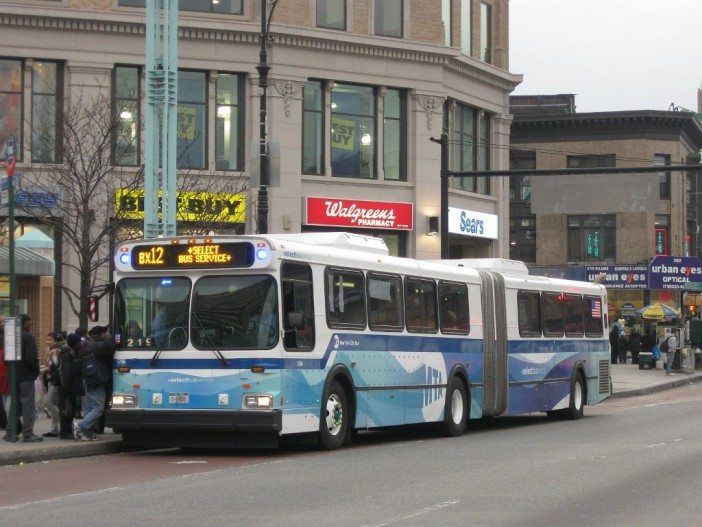The Commute: We Now Have Definitive Proof Select Bus Service (SBS) Is A Failure – Part 1 Of 2


THE COMMUTE: We know this because 2014 ridership figures are now available. The two metrics the MTA have been using to tout SBS as a success are that ridership has increased and bus trip times have been reduced by 20 percent. However, there have been no statistics whatsoever for the most important metrics: how much time passengers are saving, and how much time other road users are losing. Instead, the MTA and its proponents have been relying on the fact that bus ridership on SBS routes has been increasing during the first year of operation, using the logic that ridership increased because travel times were reduced.
However, in most cases, that is no longer true. Bus ridership figures for 2014 indicate that ridership is declining on many SBS routes at a rate greater than the borough average. So if one uses the logic that increased bus patronage means shorter passenger travel times, the converse would also be true, that a reduction in bus ridership indicates longer trip times.
Could this decline in ridership be the reason why the MTA has not released its first-year assessment for the B44 SBS due at the end of last year? Have they not yet figured out a way to twist the statistics to make it appear to be a resounding success? Apparently not.
Let’s Take A Closer Look
SBS has been implemented on the Bx12, Bx41, M15, M34, M60, S79 and B44 bus routes. The M86 will begin operation this spring and there are plans for the B46, probably next year. In 2018, Woodhaven Boulevard and Cross Bay Boulevard Bus Rapid Transit (BRT) is due to begin. I have written much about the B44 and the proposed Woodhaven routes. Let’s now take a look at all the SBS routes.
The Bronx And Manhattan
The first one was the Bx12 along Fordham Road/Pelham Parkway. Annual ridership on the SBS and local are up in 2014 by 3.4 percent more than double the borough average of 1.5 percent, surpassing the M15 as the city’s most heavily traveled bus route.
Ridership on the Bx41 increased by 21.4 percent while the borough average increased by only 1.5 percent. However, this SBS route also involved elimination of the Bx55 and a shifting of service from the Bx15 to the Bx41. So when all three routes are considered as one, the ridership increase shrinks to 8.0 percent, still impressive. However, one would have to check old schedules to determine if a service increase was at least partially responsible for the passenger gains. If you use ridership as a guideline, SBS may indeed work in the Bronx.
Now let’s look at Manhattan. Annual ridership on the M15 declined by 8.6 percent. (Statistics for local versus SBS buses are not available.) Annual ridership on the M34, which uses standard buses, declined by 11.2 percent. Manhattan local bus ridership declined by 5.8 percent. Can those SBS routes be considered successes?
The M60 local and SBS were down by 5.0 percent — slightly better than the borough average of 5.8 percent. However, the route operates partly in Queens, which is only down by a fraction of a percent when you consider both New York City Transit and MTA Bus. Those each carry about half the borough’s local bus passengers. So it has performed worse than the combined Manhattan and Queens average.
Staten Island
The S79 along Hylan Boulevard also uses standard buses and you still pay upon entering the bus. Its ridership increased by 7.2 percent. However, ridership on its local counterpart, the S78, declined by 5.7 percent. So when these two routes are considered as a group, the combined ridership increase is 2.0 percent. Local ridership throughout the borough was up by 1.9 percent. So SBS in Staten Island had minimal effect on ridership. More importantly, an increase in SBS ridership and a decrease in local ridership would indicate that local riders are walking extra distances to access the SBS. To what extent we do not know. Nor do we know the impact the extra walking has on their SBS bus travel time savings.
In Part 2, tomorrow, we will examine the B44 Nostrand Avenue SBS and future routes.
The Commute is a weekly feature highlighting news and information about the city’s mass transit system and transportation infrastructure. It is written by Allan Rosen, a Manhattan Beach resident and former Director of MTA/NYC Transit Bus Planning (1981).
Disclaimer: The above is an opinion column and may not represent the thoughts or position of Sheepshead Bites. Based upon their expertise in their respective fields, our columnists are responsible for fact-checking their own work. Their submissions are edited only for length, grammar and clarity. If you would like to submit an opinion piece or become a regularly featured contributor, please e-mail nberke [at]sheepsheadbites [dot]com.




